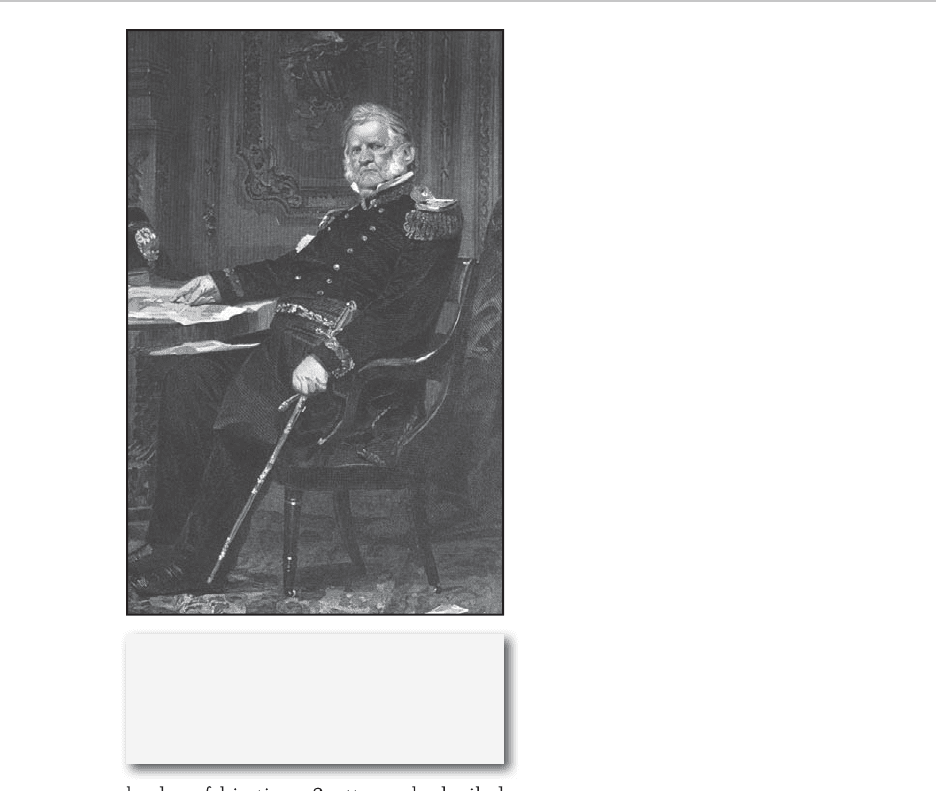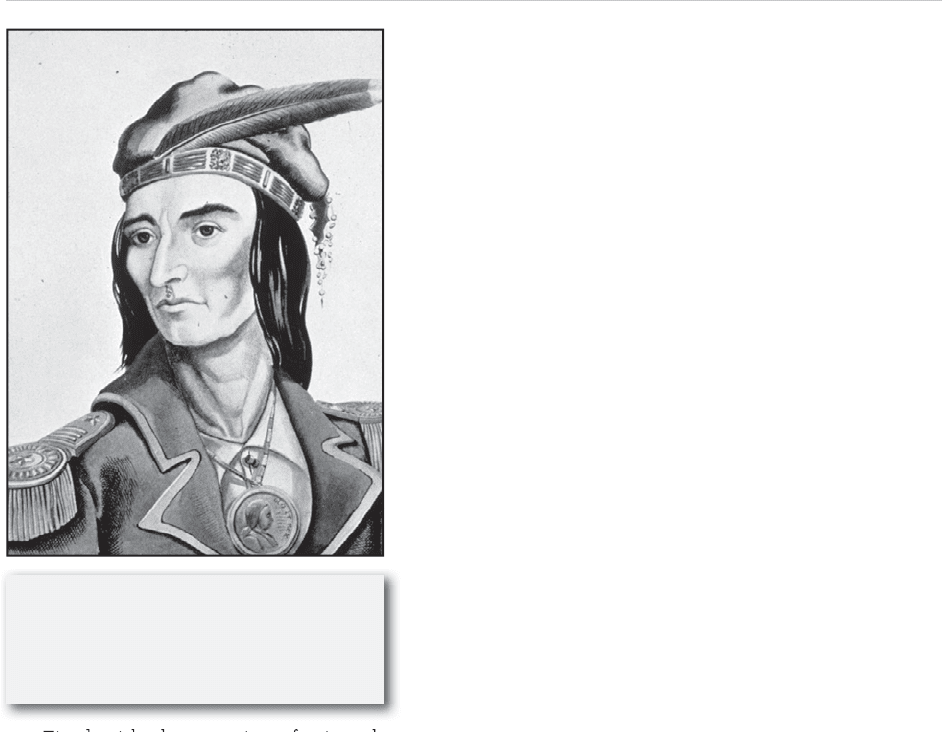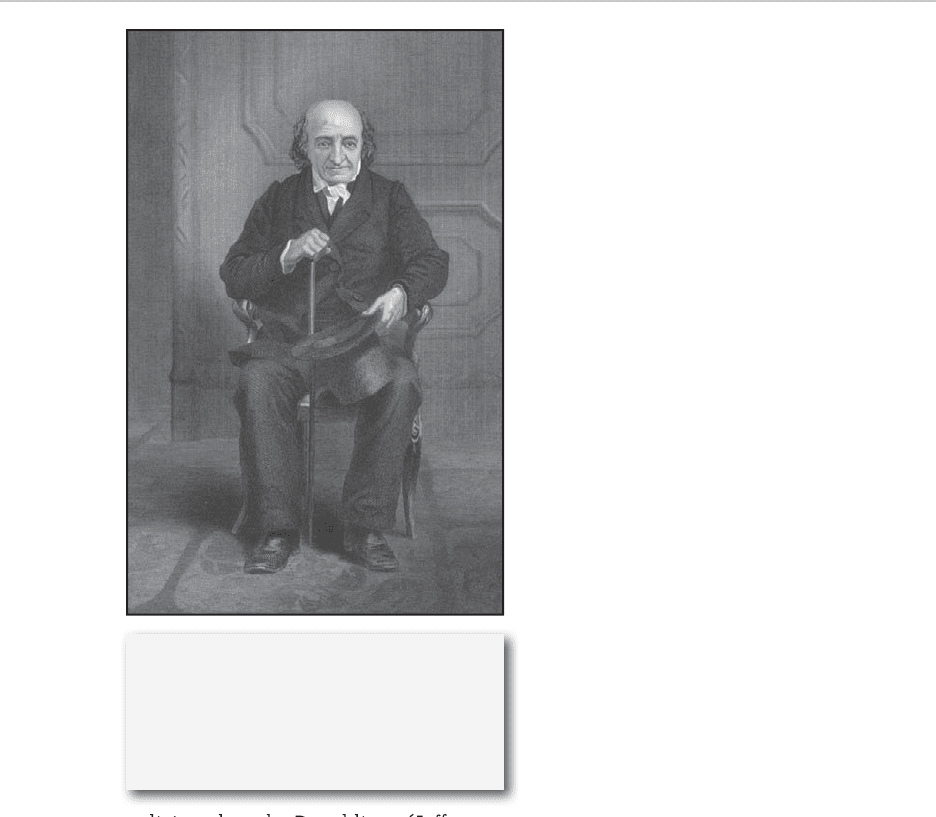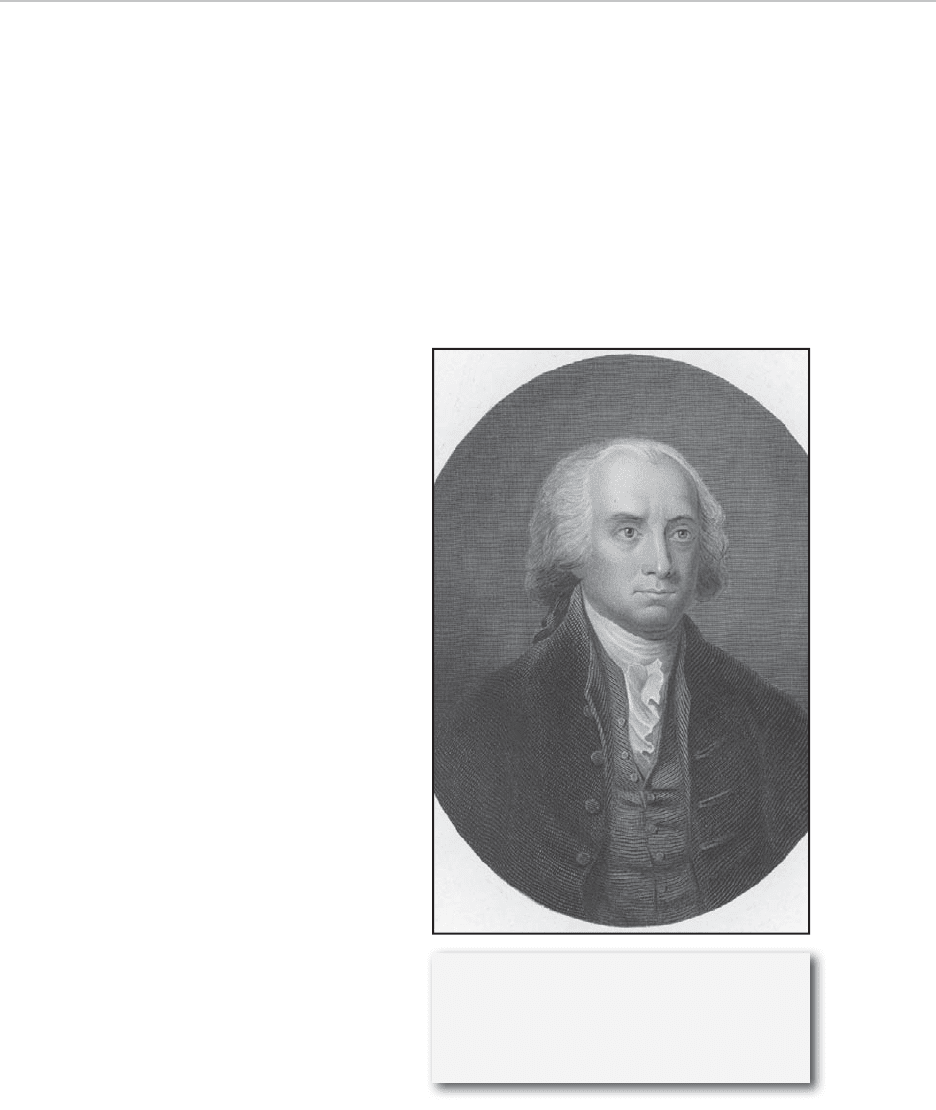Wallenfeldt J. The American Revolutionary War and the War of 1812: People, Politics, and Power
Подождите немного. Документ загружается.


he was promoted to lieutenant general,
becoming the fi rst man since George
Washington to hold that rank. Scott was
still commander in chief of the U.S. Army
when the Civil War broke out in April
1861, but his proposed strategy of split-
ting the Confederacy—the plan eventually
adopted—was ridiculed. Age forced his
retirement the following November.
Samuel Smith
(b. July 27, 1752, Carlisle, Pa.—d. April 22,
1839, Baltimore, Md.)
U.S. soldier and politician Samuel Smith
is best known as the commander of land
and sea forces that defended Baltimore
from the British during the War of 1812.
Smith grew up in Baltimore, to which
his family had moved in 1760. The son of
a wealthy merchant, he joined the family
business after lengthy travels in Europe.
Smith fought in the American Revo-
lution, participating in the Battle of Long
Island and spending the winter with
George Washington at Valley Forge. As
commander of Fort Mi in, he helped
prevent Gen. William Howe’s fl eet from
coming to the aid of Gen. John Burgoyne,
contributing to the crucial American
victory at Saratoga in 1777.
After the Revolution, Smith returned
to Baltimore, where he became quite
wealthy through land speculation as well
as the family mercantile concerns. His
main interest turned to politics. From 1793
to 1803 he won election four times to the
U.S. House of Representatives, and from
1803 to 1815 he held a seat in the Senate.
leader of his time, Scott was bedeviled
by political opposition throughout his
career. And though he was highly popu-
lar with his men, he earned the nickname
“Old Fuss and Feathers” because of his
emphasis on military formalities and
proprieties.
A prominent Whig, Scott won his
party’s presidential nomination in 1852
but lost the election to Democrat Franklin
Pierce, mainly because the Whigs were
divided over the issue of slavery. In 1855
leader of his time, Scott was bedeviled
Shown c. 1860, U.S. Army Gen. Winfi eld
Scott was known as “Old Fuss and
Feathers.” Spencer Arnold/Hulton
Archive/Getty Images
Military Figures of the War of 1812 | 215

216 | The American Revolutionary War and the War of 1812: People, Politics, and Power
“Hero of Upper Canada” during the War
of 1812.
Brock entered the British army as an
ensign in 1785. He was made lieutenant
colonel of the 49th Regiment in 1797, and
in 1802 he was sent to Canada, where he
was promoted to colonel in 1805 and
major general in 1811. In 1810 he assumed
command over all troops in Upper
Canada (now Ontario), and the following
year he took over the civil administra-
tion of the province as well. In 1812, with
the outbreak of war between Great
Britain and the United States, he ener-
getically undertook the defense of Upper
Canada against invasion and organized
the militia. On Aug. 15, 1812, with British
and Native American troops, against
great odds, he took Detroit from U.S.
forces; for this achievement he was
awarded a knighthood of the Order of
the Bath. On October 13 his troops
defeated U.S. forces at the Battle of
Queenston Heights on the Niagara
frontier, but during the battle he was
mortally wounded.
Sir George Prevost,
1st Baronet
(b. May 19, 1767, New Jersey—d. Jan. 5,
1816, London, Eng.)
Born in colonial New Jersey, George
Prevost became a soldier in the service
of Great Britain. He also served as gover-
nor in chief (1811–15) of Upper and Lower
Canada (now Ontario and Quebec) and
was known for his conciliatory policies
toward French Canadians.
During the British invasion of Mary-
land in 1814, Smith led about 13,000 troops
in defending Baltimore. The Americans
repulsed the invaders and inflicted heavy
losses on them. The American-held citadel
Fort McHenry withstood a two-day bom-
bardment (inspiring Francis Scott Key to
compose “The Star-Spangled Banner”)
before the British finally withdrew.
In 1816 Smith returned to the House
of Representatives where he stayed until
once again moving over to the Senate in
1822. He held his Senate seat until 1833,
marking 40 continuous years in Congress.
Then in 1835—at the age of 83—he took
command of the state militia and put down
riots in Baltimore. The grateful city elected
Smith mayor, and he served in that capac-
ity until 1838, one year before his death.
ThE BRITISh SIDE
Among those who fought for the British
cause in the War of 1812 were several
generals whose defense of Canada
against American incursions ultimately
set the stage for it to emerge as a sover-
eign country. Also fighting on the British
side was a famous Native American chief
who hoped that the British would help
his people keep their land.
Sir Isaac Brock
(b. Oct. 6, 1769, St. Peter Port, Guernsey,
Channel Islands—d. Oct. 13, 1812,
Queenston, Upper Can. [now Ontario])
British soldier and administrator Sir
Isaac Brock was popularly known as the

As a boy during the American
Revolution, Tecumseh participated in
combined British and Indian attacks on
American colonists. In 1794 he fought
unsuccessfully against Gen. Anthony
Wayne. With inexhaustible energy,
Tecumseh began to form an Indian con-
federation to resist white pressure. He
made long journeys in a vast territory,
from the Ozarks to New York and from
Iowa to Florida, gaining recruits (partic-
ularly among the tribes of the Creek
Confederacy, to which his mother’s tribe
belonged). The tide of settlers had pushed
game from the Indians’ hunting grounds,
and, as a result, the Indian economy had
broken down.
In 1811, while Tecumseh was in the
South, William Henry Harrison, governor
of the Indiana Territory, marched up the
Wabash River and camped near his settle-
ment. Tecumseh's brother, known as the
Prophet, unwisely attacked Harrison’s
camp and was so decisively defeated in
the ensuing Battle of Tippecanoe that his
followers dispersed, and he, having lost
his prestige, fled to Canada and ceased to
be a factor in Tecumseh’s plans.
Seeing the approach of war (the War
of 1812) between the Americans and
British, Tecumseh assembled his follow-
ers and joined the British forces at Fort
Malden on the Canadian side of the
Detroit River. There he brought together
perhaps the most formidable force ever
commanded by a North American Indian,
an accomplishment that was a decisive
factor in the capture of Detroit and of
2,500 U.S. soldiers (1812).
Prevost attained the rank of major in
the British army by 1790. From 1794 to
1796 he saw active service in the West
Indies; in 1798, as a brigadier general, he
was made lieutenant governor of St.
Lucia. He dealt successfully with the
French there, adopting a policy of con-
ciliation toward them, no doubt facilitated
by his fluency in French. He was created
a baronet in 1805 for his services in the
West Indies.
In 1808 Prevost went to Nova Scotia
as lieutenant governor. Four years later
he was transferred to Quebec, where he
was administrator of Lower Canada, then
governor in chief of both Canadas. The
previous governor, Sir James Craig, had
alienated many of the French Canadians,
but Prevost endeavoured to meet their
demands. During the War of 1812, Prevost
commanded the British forces in Canada;
his military reputation was marred by
two incidents: in 1813 he withdrew after a
successful attack on Sackets Harbor,
N.Y., and in 1814 he was defeated at
Plattsburgh, N.Y., another baing retreat.
Prevost was recalled to London in 1815 to
face a court-martial, but he died before it
was held.
Tecumseh
(b. 1768, Old Piqua, in modern Clark
County, Ohio—d. Oct. 5, 1813, near
Thames River, Upper Can.)
Shawnee Indian chief Tecumseh, long an
opponent of the expanding new American
republic, died in battle while fighting on
the British side during the War of 1812.
Military Figures of the War of 1812 | 217

218 | The American Revolutionary War and the War of 1812: People, Politics, and Power
rebu ed him. He returned north and
joined the British general Henry A.
Procter in his invasion of Ohio. Together
they besieged Fort Meigs, held by
William Henry Harrison, on the Maumee
River above Toledo, where by a stratagem
Tecumseh intercepted and destroyed a
brigade of Kentuckians under Colonel
William Dudley that had been coming to
Harrison’s relief. He and Procter failed to
capture the fort, however, and were put
on the defensive by Oliver Hazard Perry’s
decisive victory over the British fl eet on
Lake Erie (Sept. 10, 1813). Harrison there-
upon invaded Canada. Tecumseh and
his Indians reluctantly accompanied the
retiring British, whom Harrison pursued
to the Thames River, in present-day
southern Ontario. There, on Oct. 5, 1813,
the British and Indians were routed, and
Harrison won control of the Northwest.
Tecumseh, directing most of the fi ghting,
was killed. His body was carried from the
fi eld and buried secretly in a grave that
has never been discovered. Nor has it
ever been determined who killed
Tecumseh. Tecumseh’s death marked the
end of Indian resistance in the Ohio
River valley and in most of the lower
Midwest and South, and soon thereafter
the depleted tribes were transported
beyond the Mississippi River.
Fired with the promise of triumph
after the fall of Detroit, Tecumseh
departed on another long journey to
arouse the tribes, which resulted in the
uprising of the Alabama Creeks in
response to his oratory, though the
Chickasaws, Choctaws, and Cherokees
Shawnee chief and British ally Tecumseh
as painted by Mathais Noheimer,
January 1790. MPI/Hulton Archive/
Getty Images

ChAPTER 11
A
s in the American Revolution, some of the most impor-
tant e orts on behalf of the United States during the
War of 1812 came not from military men or politicians but
from civilians, including a philanthropist, who infl uenced the
outcome, and a poet, who framed the way it is remembered.
ThE AMERICAN SIDE
John Armstrong
(b. Nov. 25, 1758, Carlisle, Pa.—d. April 1, 1843,
Red Hook, N.Y.)
American soldier, diplomat, and politician John Armstrong,
who, as U.S. secretary of war during the War of 1812, was
blamed for the British capture of Washington, D.C.
Armstrong fought in the Revolution and, as an o cer in
the Continental Army, was apparently the author of the
Newburgh Addresses attacking Congress. After the war, he
entered politics in New York, serving briefl y as U.S. senator,
and from 1804 to 1810 was U.S. minister to France. When the
War of 1812 began, Armstrong served as a brigadier general
and, from February 1813 until September 1814, as secretary
of war under Pres. James Madison , with whom he shared
blame for the failure to provide men and equipment to pro-
tect Washington, D.C., from British troops, who burned the
Nonmilitary
Figures of the
War of 1812

220 | The American Revolutionary War and the War of 1812: People, Politics, and Power
U.S. politician Henry Clay practiced law
from 1797 in Virginia and then in
Kentucky, where he served in the state
legislature (1803–09). He was elected to
the U.S. House of Representatives
(1811–14, 1815–21, 1823–25); as House
speaker (1811–14), he was one of the lead-
ers who pushed the country into the War
of 1812. He also served as a member of
the commission at Ghent that drew up
the terms of peace with Britain in 1814.
He supported a national economic policy
of protective taris, known as the
American System, a national bank, and
improvements to internal transportation.
His support of the Missouri Compromise
earned him the nicknames “The Great
Pacificator” and “The Great Compro-
miser.” After his bid for the presidency in
1824 fell short, Clay threw his support to
John Quincy Adams, who made him his
secretary of state (1825–29). He served in
the U.S. Senate (1806–07, 1810–11, and
1831–42), where he supported the com-
promise tari of 1833. He was the
National Republican Party candidate for
president in 1832 and the Whig Party
candidate in 1844. In his last Senate term
(1849–52) he argued strongly for passage
of the Compromise of 1850.
Albert Gallatin
(b. Jan. 29, 1761, Geneva, Switz.—
d. Aug. 12, 1849, Astoria, N.Y.)
Albert Gallatin, the fourth U.S. secretary
of the Treasury (1801–14), insisted upon a
continuity of sound governmental fiscal
Capitol on Aug. 24, 1814. Unpopularity
forced Armstrong to resign his cabinet
position.
George Cabot
(b. Jan. 16, 1752, Salem, Mass.—
d. April 18, 1823, Boston, Mass.)
Powerful Federalist Party leader George
Cabot is remembered for his opposition
to the War of 1812 and the role he played
in the wartime Hartford Convention.
After studying at Harvard, Cabot
went to sea. He became a shipowner and
successful merchant, retiring from busi-
ness in 1794. Cabot was a member of the
Massachusetts Constitutional Convention
(1779–80), of the state Senate (1783), and
of the Massachusetts convention that
ratified the federal Constitution (1788).
He served in the U.S. Senate (1791–96),
where he was a leading supporter of the
financial policies of treasury secretary
Alexander Hamilton, and in 1793 he was
named a director of the Bank of the United
States. He was president of the Hart ford
Convention, a secret meeting called on
Dec. 15, 1814, to express the opposition of
the New England Federalists to the War
of 1812. Its report of Jan. 5, 1815, attacking
President James Madison’s administra-
tion and the war, aroused charges of lack
of patriotism from which the party,
already unpopular, never recovered.
Henry Clay
(b. April 12, 1777, Hanover County,
Va.,—d. June 29, 1852, Washington, D.C.)

Nonmilitary Figures of the War of 1812 | 221
was elected to the House of Repre-
sentatives. There he inaugurated the
House Committee on Finance, which
later grew into the powerful Ways and
Means Committee . In 1797–98 he helped
to reduce Federalist-sponsored expendi-
tures aimed at promoting hostilities with
France. He was bitterly denounced by
Federalists in Congress, and, when the
Alien and Sedition Acts were passed in
1798, Thomas Je erson believed they
were partly intended to drive Gallatin
from o ce.
As secretary of the Treasury, Gallatin
stressed simplicity in government and
termination of the public debt. Despite
heavy naval expenditures and the
$15,000,000 Louisiana Purchase (1803),
he managed to reduce the public debt by
$23,000,000 within eight years.
The declaration of war with Great
Britain in 1812 shattered all of Gallatin’s
most cherished schemes, for he felt war
to be fatal to the nation’s prosperity and
progress. He therefore put the nation’s
fi nances in the best order he could and
set himself to attain an early peace.
Grasping at Russia’s pro ered mediation
of the war, he sailed for Europe in May
1813. Refusing to deal through Russia,
Great Britain expressed its willingness
to proceed with direct negotiations, and
commissioners from the two countries
fi nally met at Ghent in August 1814. In
the tedious discussions that followed,
Gallatin played the leading role, preserv-
ing peace among his colleagues and
establishing an enviable reputation as a
policies when the Republican (Je erson-
ian) Party assumed national political
power, and he was instrumental in nego-
tiating an end to the War of 1812.
Gallatin plunged into business and
public life after immigrating to the New
World at age 19. Settling in Pennsyl-
vania, he became a mainstay of the
anti-Federalists (and, later, the Je erson-
ian Republicans) in that area and in 1795
policies when the Republican (Je erson-
Shown in an 1840 engraving after the
painting by Alonzo Chappel, Albert
Gallatin was a peace negotiator for
the War of 1812. Hulton Archive/
Getty Images

222 | The American Revolutionary War and the War of 1812: People, Politics, and Power
United States, after its charter had
expired. He renamed it the Bank of
Stephen Girard, which became known as
the “sheet anchor” of government credit
during the War of 1812. Toward the end
of the war, when U.S. credit was at its low-
est ebb, his subscription for 95 percent of
the government war loan issue enabled
the United States to carry on the war.
Subsequently he was one of Philadelphia’s
most noted civic leaders.
Girard bequeathed nearly his entire
fortune to social welfare institutions,
including an endowment for a Philadel-
phia college for male orphans, founded
as the Stephen Girard College in 1833.
Francis Scott Key
(b. Aug. 1, 1779, Frederick County,
Md.—d. Jan. 11, 1843, Baltimore, Md.)
Although a lawyer by training, Francis
Scott Key is best known as the author of
the poem that provided the lyrics to the
U.S. national anthem, “The Star-
Spangled Banner.”
In September 1814, after the burning
of the city of Washington by the British
during the War of 1812, Key was sent
to the British fleet in Chesapeake Bay to
secure the release of his friend William
Beanes, who had been captured after the
defeat of the U.S. forces at Bladensburg,
Md. He was detained aboard ship during
the shelling of Fort McHenry, one of the
forts that successfully defended Baltimore.
During the night of the bombardment,
September 13–14, Key’s anxiety was at
diplomat. Peace was signed in the Treaty
of Ghent (December 24).
While still in Europe, Gallatin was
appointed minister to France (served
1816–23), after which he returned to the
United States, only to be embroiled in a
bitter intraparty political struggle. After
serving briefly as minister to Great Britain
(1826–27), he retired from public life and
became president of the National (later
the Gallatin) Bank in New York City
(1831–39). A student of the Indian tribes in
North America, he founded the American
Ethnological Society of New York (1842)
and has sometimes been called the “father
of American ethnology.”
Stephen Girard
(b. May 20, 1750, Bordeaux, France—
d. Dec. 26, 1831, Philadelphia, Pa.)
American financier and philanthropist
Stephen Girard played a crucial role in
the War of 1812 through his purchase of
government bonds that provided eco-
nomic support for continuation of U.S.
military campaigns.
Girard shipped out to sea at the age
of 14 and by 1774 was captain of a ship
involved in U.S. coastal trade with the
West Indies. Stymied by British block-
ades of U.S. seaports during the
Revolution, he settled in Philadelphia but
resumed maritime trading after the war.
He developed a worldwide trading fleet
and scrupulously ecient business meth-
ods that laid the foundation of his fortune.
In 1812 he bought out the first Bank of the

Francis Scott Key, c. 1805. Hulton
Archive/Getty Images
adopted by the army and navy as the
national anthem, and in 1931 it was o -
cially adopted by Congress.
James Madison
(b. March 16, 1751, Port Conway, Va.—
d. June 28, 1836, Montpelier, Va.)
James Madison was serving as the fourth
president of the United States (1809–17)
when the War of 1812 broke out and over-
saw its conduct.
Early Life
After graduating from the College of New
Jersey (now Princeton University), he
served in the Virginia state legislature
(1776–80, 1784–86). At the Constitutional
Convention (1787), his Virginia, or large-
state, Plan furnished the Constitution’s
basic framework and guiding principles,
earning him the title “father of the
Constitution.” To promote its ratifi cation,
he collaborated with Alexander Hamilton
and John Jay on the Federalist Papers, a
series of articles on the Constitution and
republican government published in
newspapers in 1787–88 (Madison wrote
29 of the 85 articles). In the U.S. House of
Representatives (1789–97), he sponsored
the Bill of Rights. He split with Hamilton
over the existence of an implied congres-
sional power to create a national bank;
Madison denied such a power, though
later, as president, he requested a national
bank from Congress. In protest of the
Alien and Sedition Acts, he drafted one
high pitch, and in the morning when he
saw the American fl ag still fl ying over
the fortress, he wrote “The Star-Spangled
Banner.” Released that day, he rewrote
the poem in a Baltimore hotel. It was
printed anonymously under the title
“Defence of Fort M’Henry” and on
September 20 was published by the
Baltimore Patriot . Set to the tune of an
English drinking song, “To Anacreon in
Heaven,” it soon became popular
throughout the nation. It was later
Nonmilitary Figures of the War of 1812 | 223

224 | The American Revolutionary War and the War of 1812: People, Politics, and Power
attempting to trade with France. Madison
expelled the minister’s successor for
charging, falsely, that the president had
been aware of the violation.
Believing that England was bent on
permanent suppression of American
commerce, Madison proclaimed non-
intercourse with England on Nov. 2, 1810,
and notifi ed France on the same day that
this would “necessarily lead to war”
unless England stopped its impressment
of the Virginia and Kentucky Resolutions
in 1798 (Thomas Je erson drafted the
other). From 1801 to 1809 he was
Je erson’s secretary of state.
Madison’s Presidency
Although he was accused of weakness in
dealing with France and England,
Madison won the presidency in 1808 by
publishing his vigorous diplomatic dis-
patches. Faced with a senatorial cabal on
taking o ce, he made a senator’s lacklus-
tre brother, Robert Smith, secretary of
state and wrote all important diplomatic
letters for two years before replacing him
with James Monroe. Although he had
fully supported Je erson’s wartime ship-
ping embargo , Madison reversed his
predecessor’s policy two weeks after
assuming the presidency by secretly
notifying both Great Britain and France,
then at war, that, in his opinion, if the
country addressed should stop interfering
with U.S. commerce and the other bellig-
erent continued to do so, “Congress will,
at the next ensuing session, authorize
acts of hostility . . . against the other.”
An agreement with England provid-
ing for repeal of its Orders in Council ,
which limited trade by neutral nations
with France, collapsed because the
British minister violated his instructions;
he concealed the requirements that the
United States continue its trade embargo
against France, renounce wartime trade
with Britain’s enemies, and authorize
England to capture any U.S. vessel
James Madison, fourth president of the
United States and co-author of the Fed-
eralist papers, c. 1810. Hulton Archive/
Getty Images
